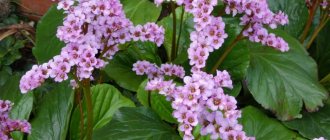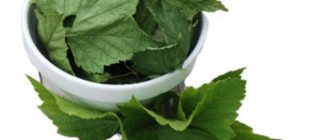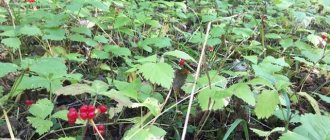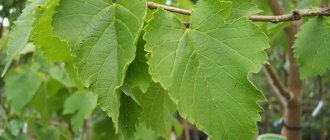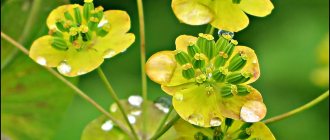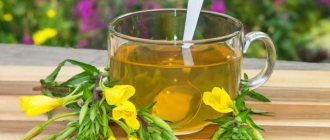Many people know that gooseberries are quite beneficial for our health, and all thanks to their valuable composition. But not everyone knows what the beneficial properties and contraindications of gooseberry leaves are. But in fact, this part of the plant is valued quite highly in folk medicine, since in terms of the content of important substances it is in no way inferior to fruits.
Application in medicine
How does the use of gooseberry leaf preparations affect the human body?
- Reliable protection against anemia - the leaves of this plant are rich in organic acids, in particular folic acid, and microelements, which fight anemia.
- Blood circulation and metabolic processes are improved due to the presence of malic acid, which is famous for its positive effect on the human body and its ability to strengthen the immune system.
- The functioning of the digestive system returns to normal, fat deposits are burned and the body is cleansed of harmful substances - malic acid is responsible for all these processes.
- Energy metabolism is restored, the functioning of the nervous system improves, brain cells are activated and the body’s ability to resist negative external factors increases, since gooseberry leaves contain valuable citric acid.
- The walls of blood vessels are strengthened due to the content of flavonoids, which are also able to neutralize the activity of free radicals; Thanks to them, the leaves of this plant exhibit antioxidant effects.
- The presence of tannins allows gooseberry leaves to exhibit several medicinal properties, including hemostatic, anti-inflammatory and bactericidal.
In addition, preparations from this part of the plant are often prescribed for complex therapy of urolithiasis - they help remove stones from the kidneys and restore the activity of this organ.
Recommendation! Do you find it difficult to wake up in the morning and even a cup of strong coffee doesn’t help? Change your drink! Brew young leaves and get an excellent tonic tea!
Recipes
- Finely chop the gooseberry leaves with a knife, separate a tablespoon;
- put the raw materials in a thermos and pour a glass of boiling water;
- Close tightly and leave for 30 minutes;
- After this time, filter the infusion.
Take the finished product 30-35 minutes before meals three times a day. This infusion is highly effective for arthritis, osteochondrosis, obesity and tuberculosis.
- Grind 2 tablespoons of raw materials and place in a saucepan;
- pour in 3 cups of water and set the container on fire;
- bring the contents of the saucepan to a boil, reduce the gas supply to the minimum mark and cook for about 5-7 minutes;
- Remove the broth from the stove, let cool and filter.
Taking this remedy becomes relevant for ulcers on the tongue and mouth, as well as for diarrhea and dysentery. In addition, this decoction is perfectly refreshing on a hot day and helps avoid dehydration.
Important! A decoction of gooseberry leaves has a rather serious side effect: it increases the risk of bleeding during and after surgery. Therefore, you should stop using this drug at least 2 weeks before surgery!
As you can see, the range of beneficial properties of gooseberry leaves is quite wide. For this reason, traditional medicine recommends harvesting them along with berries. They will have a positive effect on metabolic processes in the body, eliminate joint pain and even improve the general condition of such a serious disease as tuberculosis.
In addition, taking gooseberry leaf preparations internally does not end there. Decoctions and infusions can strengthen hair roots and cure some skin diseases.
Attention - contraindication!
Like any other medicine, gooseberry leaf is not useful for everyone. Decoctions and infusions based on it have the only contraindication for use – diseases of the gastrointestinal tract.
Use the gifts of nature wisely and carefully, and they will definitely bring only benefits! Be healthy!
All materials on the Priroda-Znaet.ru website are presented for informational purposes only. Before using any product, consultation with a doctor is MANDATORY!
The variety of beneficial properties of burdock root - but do not forget about contraindications
Properties of creeping clover for mighty health! He heals wounds, hemorrhoids, and he will fight tuberculosis!
Wintergreen will help with ulcers, cystitis, bleeding and prostatitis!
How to take black cumin only with benefit and without harm to health?
Good afternoon, dear readers. We all use berries from various plants and are familiar with their advantages and disadvantages. Today I would like to discuss with you an interesting topic not related to fruits: “gooseberry leaves, beneficial properties and contraindications.”
Use of leaves as a medicine
Do you know what medications based on gooseberry leaves can bring to the body? It turns out that there are many positive properties, thanks to the components inside them:
- Leaf tannins have the following properties: bactericidal, anti-inflammatory, hemostatic;
- malic acid improves metabolic processes, the immune system, and blood circulation. Cleanses the body of toxins, promotes fat burning;
- citric acid helps to reorganize the energy balance, increases resistance to a negative external environment, activates brain cells, and increases the performance of the nervous system;
- flavonoids strengthen the walls of blood vessels, neutralize the work of free radicals and the leaf works as an antioxidant.
- Decoctions have positive properties for skin diseases and strengthen hair;
- rinsing the mouth with a decoction helps maintain a healthy microclimate;
- removes stones from the kidneys and helps to recover;
- decoctions and tinctures are used for tuberculosis, arthritis, osteochondrosis;
I advise you to take brewed young leaves instead of a cup of coffee or tea. The drink perfectly tones the body in the morning. Also read about ginger tea.
Contraindications for the drug on gooseberry leaves
The use of decoctions and tinctures on gooseberry leaves is not available to everyone. This applies to people with diseases of the gastrointestinal tract (gastrointestinal tract). Peptic ulcers of the stomach, duodenum, enterocolitis, colitis may worsen.
Kidney disease - you need to use medications with care, avoid overdose.
Recipes
Infusion
- Chop gooseberry leaves (1 tbsp), put in a thermos and pour boiling water (1 cup). Everything is infused for about 30 minutes. Then, strain and drink 3 times a day.
- Dosage: 1/3 of a glass before meals 30 minutes.
- The infusion is effective for tuberculosis, obesity, osteochondrosis, and arthritis.
Decoction
Combine 3 tbsp. l. leaves with 3 glasses of water and put on fire. Boil for 6 minutes. Cool and strain.
The decoction is useful for oral ulcers, dysentery, and diarrhea. On a hot day, the product perfectly tones, refreshes the body, and prevents dehydration.
Contraindications for decoction. Let's say you're going to have surgery, a few weeks before surgery, you need to stop taking it. Because it may cause bleeding during or after surgery.
As you can see, leaves have much more positive properties than negative ones. Therefore, you can stock up for the winter not only with berries, but also with leaves. To do this, collect them and rinse under running water. Dry in the shade.
Before I say goodbye, I want to invite you to subscribe to blog updates and share useful information with your friends on social media. networks “gooseberry leaves beneficial properties and contraindications”, leave a comment. See you again and be healthy.
- 5
- 4
- 3
- 2
- 1
Rating: 5 out of 5 (8 votes)
Best regards, Vladimir Manerov
Subscribe and be the first to know about new articles on the site, directly in your email:
Comments to the article: 6
I love gooseberries and think that they are a worthy berry in all respects, but I haven’t paid enough attention to the leaves before. I will try to make an infusion in the morning instead of tea, as I think this article is correct.
Cleaning vessels with green gooseberries
To cleanse the blood, reduce cholesterol and prevent the development of atherosclerosis, you need to eat 10 unripe green gooseberries twice a day.
Green unripe gooseberries are good for blood vessels
You need to eat the unripe gooseberries along with the dried tails that have not yet fallen off. They also contain useful elements. This course is worth taking for two or three weeks every summer. This will help maintain good health and well-being throughout the year.
More detailed information about the beneficial properties of gooseberries is in the article.
Are gooseberry leaves healthy?
In Ancient Rus', gooseberries began to be grown in gardens back in the 11th century. Until this moment, it was a wild species. Today, gooseberries are known on almost all continents where there is a temperate climate zone. And everyone knows about the benefits of leaves, which are rich in nutrients. Most often they are used for colds and viral diseases, as they contain large amounts of vitamin C and antioxidant substances that help remove toxins from the body. The diuretic, choleretic, and anti-inflammatory properties of gooseberry leaves are also noted.
Composition and value of gooseberry leaves
The beneficial properties of gooseberry leaves lie in their chemical composition. It differs significantly from the composition of the berries. However, the effect of decoctions, infusions and tea from gooseberry leaves is also somewhat different from the effect of gooseberry compote or juice.
They are used for medicinal purposes to meet the body’s needs for substances such as:
- Ascorbic acid, which significantly increases the body's defenses against viral diseases;
- Malic acid, which triggers metabolic processes in the body, stimulates the circulatory system and is responsible for the formation of natural collagen. The latter is especially important for women. Its sufficient amount allows the skin to remain firm and elastic.
- Lemon acid. A product that helps remove harmful substances from the body, including radionuclides. In addition, it gently cleanses the intestines and can be used as a means for weight loss.
- Folic acid is one of the essential substances during pregnancy. Without it, proper cell division and, accordingly, fetal development are impossible. Folic acid deficiency in children and adults leads to disturbances in the functioning of the hematopoietic system and the development of various types of anemia.
- Retinol or vitamin A, which is a powerful antioxidant, is used as a means of preventing the appearance of tumors. A lack of retinol manifests itself in decreased visual acuity, night blindness, brittle nails and hair, and dull skin color with a yellowish tint.
- All B vitamins. Without these substances, not a single organ of the human body can function normally. With their deficiency, disruptions in the endocrine, cardiovascular and nervous systems are most pronounced.
- Vitamin E, which is rich in tea with gooseberry leaves, will help maintain youth. It has a rejuvenating effect on the entire body, but has a greater effect on the beauty and health of the skin.
- Tannins. They have anti-inflammatory and antibacterial medicinal properties, making decoctions and infusions of gooseberry leaves useful for lesions of the skin and mucous membranes.
Composition of gooseberry berries and leaves
The chemical composition of gooseberries depends on the variety, growing and storage conditions. The fruits contain:
- organic acids;
- alimentary fiber;
- water;
- ash;
- vitamin A;
- beta-carotene;
- B vitamins: B1, B2, B3, B4, B5, B6, B9;
- vitamins C, E, H, K, PP;
- macroelements: potassium, calcium, silicon, magnesium, sodium, sulfur, phosphorus, chlorine;
- trace elements: aluminum, boron, vanadium, iron, iodine, cobalt, lithium, manganese, copper, molybdenum, nickel, selenium, strontium, fluorine, chromium, zinc, zirconium;
- digestible carbohydrates: glucose, sucrose, fructose;
- saturated fatty acids;
- omega-3 fatty acids.
The chemical composition of the leaves is no less diverse. It contains such valuable substances for the human body as:
- vitamins A, C, E;
- B vitamins: thiamine, riboflavin, niacin, choline, pantothenic and folic acids, pyridoxine;
- organic acids: malic, citric, oxalic;
- tannins;
- flavonoids;
- pectin;
- minerals.
What are the benefits of gooseberry leaves for the human body?
The use of gooseberry leaves brings tangible health benefits. And most importantly, tea, decoctions and infusions have a rather pleasant, sour taste. There is no pronounced bitterness in them. It is easy to persuade a child to drink the drink. Their use:
- Strengthens the immune system. Serves as an excellent preventive measure during influenza and ARVI epidemics.
- Helps improve the functioning of the circulatory system and the condition of blood vessels in general.
- The diuretic effect of gooseberries is used to get rid of extra pounds and cleanse the body of toxins.
- The mild effect that decoctions and infusions have on the digestive system helps with poisoning, diarrhea, and cholelithiasis.
- Promotes the production of blood cells, in particular helps to increase hemoglobin levels in children and pregnant women.
Preparations prepared on the basis of gooseberry leaves whiten the skin, relieve inflammation, reduce pores, get rid of acne, and give the skin elasticity and a blooming appearance. People suffering from joint diseases such as arthritis and arthrosis have heard well about the anti-inflammatory properties of gooseberry leaves.
Application area
Gooseberry leaves, the medicinal properties and contraindications of which are scientifically substantiated, are used in the following areas of medicine:
- Strengthening the immune system. Due to their high content of ascorbic acid, they have a powerful antiviral and antibacterial effect, which justifies their effective use as a prophylactic agent during influenza and ARVI epidemics.
- Supports the functioning of the cardiovascular system. Regular use of a decoction based on the leaves of the bush helps strengthen the walls of blood vessels and the proper functioning of the circulatory system, which is due to its high content of folic acid and B vitamins. Experts recommend using this remedy to increase hemoglobin levels, as well as to reduce cholesterol and blood sugar levels .
- Improving the functioning of the nervous system. Due to the high content of citric acid and B vitamins, the use of shrub leaves helps to activate brain cells, normalize emotional background, and restore the body after prolonged stress.
- Dietetics. The presence of malic acid in the composition determines the use of the leaf to normalize the functioning of the digestive system and stabilize metabolism. Due to its ability to stimulate intestinal motility and burn fat deposits, as well as have a diuretic effect, the drug is actively used in various weight loss programs.
- Cosmetology. The presence of tannins in the composition allows them to have anti-inflammatory and antibacterial effects. To reduce inflammation on the facial skin, get rid of acne and age spots, compresses based on infusion are used. Taking the decoction orally helps to increase the skin's production of collagen, improve its tone, and normalize the functioning of the sebaceous glands.
- Treatment of diseases of the musculoskeletal system. Compresses based on the product help stop the inflammatory process, which justifies their use for arthritis and arthrosis.
- Dentistry. An infusion based on the leaves of the plant is used to treat inflammatory diseases of the oral cavity (gingivitis, stomatitis, periodontal disease). Tannins in the leaves help to cope with the problem of bleeding gums.
- Treatment of liver and kidney diseases. Regular use of a decoction based on the leaves of the plant for several months helps remove kidney stones and also improves the flow of bile.
We recommend checking out Barberry Pink Queen
Benefits of gooseberry leaf tea
Gooseberry leaf tea is an excellent tonic. It will give you a vitamin boost of energy for the whole day. It is useful to drink during colds and viral diseases, both as an auxiliary medicine and for preventive purposes. In the spring it will fill the body with vigor, in the summer it will quench thirst and help endure the heat, and in the fall it will relieve the blues. If we talk about the benefits and harms of gooseberry leaf tea, it is worth noting that it is not as effective as infusions and decoctions, and is not a medicine.
When to collect gooseberry leaves for tea
Gooseberry leaves are collected after the end of fruiting in August or September. It is believed that this is when they contain the maximum amount of useful substances. Unfortunately, modern climatic realities do not allow us to say for sure that by this period the leaves will not dry out or wither, or will not be damaged by pests or fungal diseases. Many gardeners collect at the time of flowering, picking a small number of flowers.
To obtain high-quality raw materials, gooseberry leaves are picked in dry weather, late in the morning, when the dew has already dried and the sun has not yet begun to get hot. Pluck whole, dark green leaves without signs of disease.
How to dry gooseberry leaves for tea
Dry the collected raw materials in a warm place with good ventilation and out of direct sunlight. The leaves are poured onto paper and left. Turn over periodically and inspect for mold and readiness. They are considered ready when they begin to break. The dry composition is stored in tightly closed jars, away from light.
How to brew and drink tea from gooseberry leaves
To brew an aromatic drink, mix 2 teaspoons of gooseberry leaves and black tea. Place in a teapot, pour boiling water over it and leave for 5-10 minutes. For taste, add cinnamon, mint, lemon balm or a couple of slices of lemon.
What do gooseberry leaves help with?
For treatment, decoctions and infusions of gooseberry leaves are used. They contain a higher concentration of nutrients than tea. The infusion is prepared as follows. Take 2 tablespoons of dry gooseberry leaves and pour 400 ml of boiling water over them. To brew the infusion, use a thermos or kettle with an airtight lid. Leave for an hour. The infusion is used:
- As a general strengthening and auxiliary remedy for tuberculosis. For a month, drink one glass of infusion in the morning, after breakfast.
- To increase vitality and replenish the supply of vitamins in the spring, also take a glass of infusion during the day. To increase efficiency, currant and raspberry leaves and dried gooseberries are added to the drink.
- For inflammatory processes of the genitourinary system, such as cystitis, pyelonephritis, the infusion is consumed for a week, 100 grams 5-6 times a day.
- If you are following a diet, drink an infusion of gooseberry leaves after meals 1-2 times a day. It will remove excess fluid and saturate the body with vitamins and microelements.
Contraindications for taking gooseberry leaves
Despite the fact that numerous reviews confirm the medicinal properties of gooseberry leaves, they also have contraindications. Do not ingest decoctions and infusions for stomach ulcers, colitis, liver and kidney diseases in the acute stage.
Don't forget about allergic reactions. Before using a decoction of gooseberry leaves as compresses or lotions, it is worth conducting a simple test. A small amount of the treatment is applied to the skin of the inner surface of the forearm or wrist. If after an hour there is no redness, itching or burning, then everything is fine.
The use of berries in folk medicine
Ways to use gooseberries in folk medicine:
- berries and a decoction of leaves are used in the treatment of tuberculosis;
- Gooseberry juice in combination with honey is good for eliminating sore throat (treatment of sore throat, laryngitis, pharyngitis);
- a decoction of the berries is used as an external remedy for erysipelas, eczema, dermatitis;
- freshly squeezed juice has an anti-inflammatory effect in genitourinary diseases;
- prevention of the formation of kidney stones with regular consumption of gooseberries;
- reduction of high blood pressure due to a pronounced diuretic effect;
- a decoction of the leaves helps reduce fever during colds;
- removal of toxins and waste from the body prevents the development of oncological processes;
- production of the required amount of hemoglobin, improvement of amino acid metabolism due to the presence of the molybdenum element in the composition (taking a decoction of the leaves daily in the amount of 70 ml);
- a decoction of gooseberry leaves in a ratio of 100 grams of raw material per 250 ml of water is used to prepare compresses during the treatment of arthritis and other vascular diseases;
- a decoction of the leaves of the bush eliminates pain in the joints and spine (the finished product is taken 50–60 ml daily);
- potassium promotes the activation of thought processes and improves brain activity.
